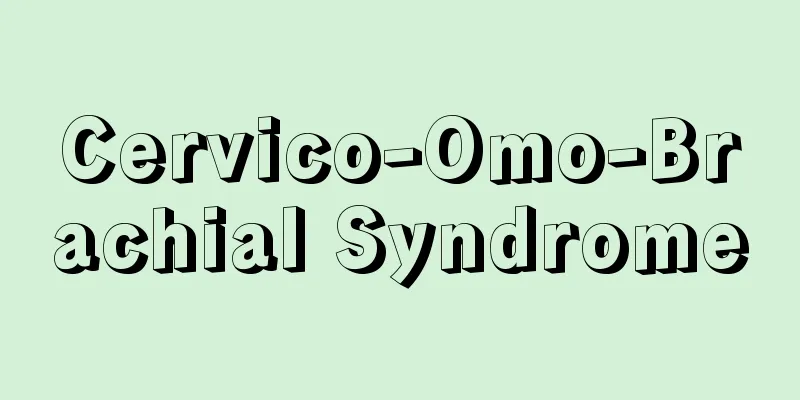Cervico-Omo-Brachial Syndrome

|
When various illnesses are causing symptoms such as pain, numbness, fatigue, loss of strength, or coldness in the neck, shoulders, arms, or fingers, the condition may be conveniently named "cervical-shoulder-arm syndrome," regardless of the underlying disease. Therefore, the name of this disease is simply a description of the symptoms, and is a general term for a range of symptoms that are caused by a variety of illnesses. For this reason, although this name was commonly used in the past, it has become less commonly used in recent years. In fact, during continued treatment, the underlying disease is often revealed through physical examinations and X-rays, in which case the name of the disease is no longer called cervico-brachial syndrome and is replaced by the correct diagnosis. Diseases that cause neck-shoulder-arm syndrome include degenerative cervical spondylosis ("cervical spondylosis (cervical degenerative spondylosis)"), cervical disc herniation, ossification of the posterior longitudinal ligament of the cervical spine ("ossification of the posterior longitudinal ligament of the cervical spine"), and thoracic outlet syndrome ("thoracic outlet syndrome"). If the cause is unclear, the condition will be referred to as cervicobrachial syndrome (sometimes called cervicobrachial disorder). It is most important to accurately diagnose the underlying disease, and treatment will be based on that. If the cause is unknown, painkillers and heat therapy are administered depending on the symptoms, and the underlying disease may become clear through this treatment. However, if the cause remains unclear and the symptoms do not improve, some people may become depressed or visit various hospitals in an attempt to find the cause, which may make their symptoms even more complicated. The fact that the cause is unclear should not be taken as proof that there is no serious illness, so it is important to patiently receive symptomatic treatment rather than transferring to another hospital easily. Source: Shogakukan Home Medical Library Information |
|
◎いろいろな病気が原因に くび、肩、腕、手指にかけて、痛みやしびれ、だるさ(倦怠感(けんたいかん))、力が抜ける感じ(脱力感)、冷たさ(冷感)などの訴えがある場合、その原因疾患がなんであるかはさておき、便宜上、「頸肩腕症候群」という病名をつけることがあります。 したがってこの病名は、症状に対してつけられたものにすぎず、さまざまな病気が原因となって一連の症状をひきおこしているものを総称していることになります。 こうしたことから、昔はこの病名がよく使われていましたが、最近ではあまり使われなくなっています。 事実、診療を続ける間に、診察やX線検査などで、原因となっている病気が明らかになることが多く、その場合、頸肩腕症候群の病名はなくなり、正しい診断名にかわります。 頸肩腕症候群をきたす病気としては、変形性頸椎症(へんけいせいけいついしょう)(「変形性頸椎症(頸部変形性脊椎症)」)、頸椎椎間板(けいついついかんばん)ヘルニア、頸椎後縦靱帯骨化症(けいついこうじゅうじんたいこつかしょう)(「頸椎後縦靱帯骨化症」)、胸郭出口症候群(きょうかくでぐちしょうこうぐん)(「胸郭出口症候群」)などが多いものです。 原因がはっきりしない場合は、頸肩腕症候群の病名(頸肩腕障害(けいけんわんしょうがい)と呼ぶこともある)が残ることになります。原因である病気が的確に診断されることがもっとも重要で、治療はそれに基づいて行なわれます。 原因不明の場合は、症状に応じて鎮痛薬の投与や温熱療法が行なわれますが、そのなかで、原因となっている病気がはっきりしてくることもあります。 しかし、いつまでも原因がはっきりせず、症状も改善しない場合は、人によっては精神的に落ち込んだり、また、原因究明を求めて、あちこちの病院を受診し、症状がさらに複雑になることがあります。 原因がはっきりしないということは、大きな病気がない証拠だと思って、安易に転院したりせずに、根気よく対症療法を受けることも必要です。 出典 小学館家庭医学館について 情報 |
Recommend
What it means - What it means
…The functions of these similarity associations a...
Agricultural Research Institute - Nougyousougokenkyujo
Founded in 1946 under the jurisdiction of the Agri...
Saga Domain
Also called Hizen Domain. A large outside domain ...
Air transport - kuukiyusou
...The Japanese-Portuguese Dictionary, which incl...
Sofu Teshigahara
Ikebana artist. First head of the Sogetsu school. ...
Varadero (English spelling)
Located in the northwest of Cuba, in Matanzas Prov...
Mathieu, G.
...Originally, it was derived from Pollock, who w...
Voice tone - Scary
A type of performing art that accompanies theater...
Shangjing Huiningfu (English spelling)
The site of an early Jin Dynasty capital city in B...
Shingon-in Temple
This was a training hall for ascetic practices of ...
Laws on foreign capital - Laws on insulators
Law No. 163 of 1950. It is also known as the Forei...
Musaka
...Although the names of dishes derived from Turk...
Olcott, HS - Olcott
…The term “theosophy” is always used to describe ...
Kongo Sammai-in Temple
A Shingon Buddhist temple in Koya-cho, Wakayama Pr...
Mazus miquelii (Mazus miquelii)
A perennial plant of the Scrophulariaceae family. ...




![Korean Air [company] - Korean Air](/upload/images/67cc157398023.webp)




